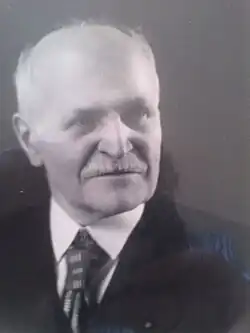Henri Dulac
Henri Dulac | |
|---|---|
 | |
| Born | Henri Claudius Rosarius Dulac October 3, 1870 Fayence, France |
| Died | September 2, 1955 (aged 84) Fayence, France |
| Nationality | French |
| Education | École polytechnique |
| Alma mater | École centrale de Lyon |
| Occupation | Mathematician |
| Children | 3 |
Henri Claudius Marie Rosario Dulac (3 October 1870, Fayence – 2 September 1955, Fayence) was a French mathematician.[1]
Life
Born in Fayence, France, Dulac graduated from École Polytechnique (Paris, class of 1892) and obtained a Doctorate in Mathematics.[1] He started to teach a class of mathematic analysis at University, in Grenoble (France), Algiers (today Algeria) and Poitiers (France).[1] Holder of a pulpit in pure mathematics in the Sciences University of Lyon (France) in 1911, his teaching was suspended during the First World War (1914 – 1918) and he had to serve as officer in the French army.[1] After the war, he became holder of a pulpit of differential and integral calculus and also taught in École Centrale Lyon.[1] He became examiner at École Polytechnique (Paris) and President of the admission jury.[1] Awarded Officer of Legion d'honneur, the French order established by Napoleon and associate member of the French Academy of Sciences, he published part of Euler's works[1] and contributed to the research through many publications in France and abroad.
Father of 3 children, Anie (1901–1935), bachelor in mathematics, Jean (1903–2005), graduate of École Polytechnique, 1921 and Robert (1904–1996), graduate of polytechnique, 1922; he died in Fayence, France, in 1955.
Work
Among his publications:
- Recherches sur les points singuliers des équations différentielles (Journal of École Polytechnique, 1904).
- Intégrales d'une équation différentielle (Annales University of Grenoble, 1905).
- Sur les Points dicritiques (Journal of mathématics, 1906).
- Sur les séries de Mac-Laurin à plusieurs variables (Acta Mathematica, 1906).
- Détermination et intégration d'une classe d'équations différentielles (Bulletin of mathematical sciences).
- Intégrales passant par un point singulier (Rendeconti del Circolo, 1911).
- Sur les points singuliers (Annales, Toulouse, 1912).
- Solutions d'un système d'équations différentielles (Bulletin of the mathematical society, 1913).
- Sur les cycles limites (Bulletin of the mathematical society, 1923).
- Points singuliers des équations différentielles (Mémorial des sciences mathématiques, 1932).
- Courbes définies par une équation différentielle du premier ordre (Mémorial des sciences mathématiques, 1934).
His researches are still mentioned or challenged by international university PHD students and professors, even a hundred years after being published. As an example:
- The Center Variety of Polynomial Differential Systems – Abdu Salam Jarrah, Faculté des sciences mathématiques, Université du Nouveau Mexique, USA (2001).
- Complete Polynomial Vector Fields on C2 – Julio Rebelo, Institute for Mathematical Sciences, SUNY, New York, USA (Oct. 2002).
- Dimension Increase and Splitting for Poincaré-Dulac Normal forms – Giuseppe Gaeta, Faculté de Mathématique de l'Université de Milan and Sebastian Walcher, chaire de Mathématique, Aix La Chapelle, Journal of Non linear Mathematical Physices (2005).
Sources: Technica, n° 190, Nov. 1955, École Centrale Lyon, French Academy of Sciences, updated by Louis Boisgibault, his great grandson.